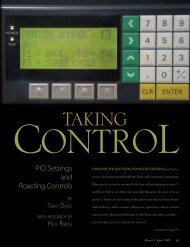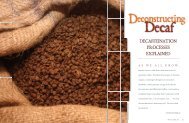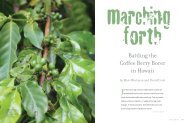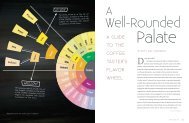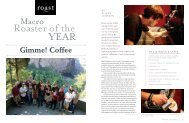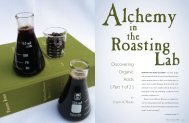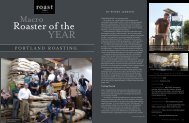Blowing Smoke - Roast Magazine
Blowing Smoke - Roast Magazine
Blowing Smoke - Roast Magazine
Create successful ePaper yourself
Turn your PDF publications into a flip-book with our unique Google optimized e-Paper software.
<strong>Blowing</strong><br />
smoke<br />
W a y s t o C l e a n u p ,<br />
R e d u c e a n d R e c i r c u l a t e<br />
<strong>Roast</strong>er Emissions<br />
by Joachim Eichner<br />
a n d VISHWA ADLURI<br />
MOST of us who roast, cup and market coffee do so because we love<br />
coffee. But in the heat of passion, one should remember that coffee roasting is<br />
a business as well. This is true whether we’re setting coffee prices, dealing with<br />
customers, or taking care of those nearly invisible but very important issues, such<br />
as emissions control.<br />
Forethought about emission control prevents loss of friendly neighbors,<br />
guilty conscience and expensive penalties for non compliance. Dealing with<br />
emissions proactively is not only good for the environment, but also good for<br />
your business and, surprisingly, could be good for the quality of your coffee.<br />
continued on page 26<br />
24 roast September September | October | October 2006 200625<br />
25
<strong>Blowing</strong> <strong>Smoke</strong>: Ways to Clean Up <strong>Roast</strong>er Emissions (CONTINUED)<br />
WHY?<br />
Having spent decades helping roasters<br />
reduce and eliminate emissions produced<br />
by coffee roasting, I realized that I really<br />
never checked into what penalties and<br />
fines could accrue from non-compliance<br />
to environmental standards. I’m not the<br />
only guilty one here—many roasters also<br />
do not know the emissions regulations<br />
in their area, or the penalties they could<br />
be charged. A perfect example is Oren<br />
Bloostein, president of Oren’s Daily <strong>Roast</strong>,<br />
who I called to ask about these penalties.<br />
His answer—“I don’t know, and I don’t<br />
ever want to know”—contained a valuable<br />
lesson. It isn’t that Bloostein doesn’t care<br />
about having emissions control—he has<br />
an afterburner system, and is investing in a<br />
catalyzer system as well. For him, he<br />
is just less interested in knowing the<br />
amount of penalties and fines than he<br />
is in preventing putting emissions into<br />
the air.<br />
There are three good reasons for<br />
roasters to address the emissions issue<br />
aggressively.<br />
Make a Profit<br />
To many of us in the business world,<br />
the economic considerations of<br />
emissions controls outweigh treehugging<br />
sentiments. But penny-wise<br />
economics is a short-sighted and<br />
ultimately expensive strategy for<br />
running a coffee-roasting business.<br />
Besides the penalties that Bloostein<br />
finds too gruesome to mention, there<br />
are several economic factors that speak<br />
out for compliance.<br />
Over the past two decades, coffee<br />
has progressively brought together<br />
countries of origin, countries of<br />
coffee processing, and countries of<br />
consumption. You cannot order coffee<br />
in a successful café without naming<br />
an exotic country such as Kenya or<br />
Sumatra. Coffee drinkers, for the<br />
most part, care about the world and<br />
the environment. Savvy roasting<br />
businesses actually appeal to these<br />
green-hearted consumers to educate<br />
as well as make a profit. For these<br />
reasons, not only do I recommend<br />
strict emissions compliance, I<br />
urge coffee roasters to become<br />
environmentally responsible, and<br />
incorporate this sentiment into their<br />
entire business plan. This can only be<br />
profitable in the long term.<br />
Love Your Mother<br />
Besides being good for your business,<br />
emissions control is obviously good<br />
for the environment. Most scientists<br />
believe that human activity is<br />
impacting the environment in many<br />
ways, with climate changes being<br />
just one indicator. The emissions we<br />
put into the air remain there, and it<br />
is our responsibility to contaminate<br />
the environment as little as possible.<br />
Emissions contain a number of<br />
chemicals that could be detrimental to<br />
the atmosphere and those breathing it.<br />
My favorite argument for remaining<br />
compliant and being environmentally<br />
responsible is not economic, but being<br />
socially responsible, and to use a<br />
stronger word, ethical.<br />
Love thy Neighbor<br />
Just as parents find their noisy<br />
children entertaining while the<br />
rest of us pop Excedrin, so too with<br />
coffee aroma. Often, neighbors find<br />
this aroma offensive and the fumes<br />
a nuisance. Penalties are costly;<br />
therefore being nice and taking<br />
preventative steps—i.e. being polite<br />
to your neighbors is the best strategy.<br />
Irate neighbors will interfere in your<br />
business constantly, and this can only<br />
distract you from running a good<br />
business and roasting good coffee.<br />
WHERE?<br />
Currently, there are no federal<br />
requirements for afterburners.<br />
Title III of the Clean Air Act charges<br />
states with the responsibility of<br />
attaining clean air quality within their<br />
jurisdictions.<br />
Since emissions standards are<br />
not the same everywhere, one could<br />
risk a guilty conscience by starting a<br />
roasting plant in a town where these<br />
compliance standards are low or in an<br />
area where emissions go undetected.<br />
To allay this guilty conscience, one<br />
could argue that they are not breaking<br />
the law.<br />
I’ve also heard the anti-Darwinian<br />
argument for such avoidance<br />
behavior: The cost of an afterburner<br />
will hurt smaller entrepreneurs.<br />
Again, my advice is not to say what<br />
people wish to hear, but what is good<br />
and right for the roaster to do. When<br />
writing a business plan, it’s a good<br />
idea to include the cost of emissions<br />
control, just as one would include<br />
calculations for health insurance.<br />
Furthermore, moving to a<br />
remote location often adds to fuel<br />
costs required to transport coffee for<br />
distribution. There are no guarantees<br />
that local emissions laws will remain<br />
unchanged forever. The slightest<br />
change in demographics of the plant<br />
location will lead to a re-evaluation<br />
of local emissions standards, so you<br />
could end up moving to the middle<br />
of nowhere, spending money to<br />
transport coffee, and eventually<br />
still face more stringent compliance<br />
requirements and associated costs.<br />
How do you find out what the<br />
emission regulations are for your area?<br />
Begin your research locally by calling up<br />
your county. Many counties and boroughs<br />
have a town engineer on duty. You can<br />
also speak to other businesses in your area.<br />
Internet research is increasingly useful,<br />
as many government agencies are posting<br />
emissions standards online.<br />
continued on page 28<br />
Free Info #178<br />
Free Info #180<br />
26 roast September | October 2006 27
<strong>Blowing</strong> <strong>Smoke</strong>: <strong>Roast</strong>er Emissions (CONTINUED)<br />
WHAT?<br />
What exactly happens when coffee is processed? Coffee<br />
processing is a laborious and lengthy endeavor, of which<br />
roasting is the most significant but by no means the only<br />
emissions-producing phase. The following diagram shows a<br />
schematic of the various stages of coffee processing as well as the<br />
various emissions produced at each stage. The drawing shows<br />
both particulate matter emissions (PMs) and volatile organic<br />
compound emissions (VOC) at each stage of coffee processing.<br />
(The SCC numbers are legalese numbers, and can be ignored.)<br />
Typical Coffee <strong>Roast</strong>ing Operation<br />
Let us now focus on the roasting process itself. Green<br />
coffee beans contain a wide variety of chemical compounds,<br />
including proteins, fats, sugars, dextrose, cellulose, caffeine<br />
and organic acids. When heat is applied to these beans<br />
during roasting, some of these compounds volatize, oxidize<br />
or decompose into toxic by-products of the roast. Unless<br />
roasters are connected to thermal or catalytic oxidizers, toxic<br />
compounds such as aldehydes (as formaldehydes), organic<br />
acids (as acetic acid), volatile organic compounds (VOCs,<br />
responsible for much of roast coffee’s characteristic odor) and<br />
arcolein are then exhausted into the atmosphere.<br />
Emissions can be subcategorized into two different types:<br />
gaseous and particulate matter. Suspended particulate matter<br />
is often visible as smoke. The clear bluish white gaseous<br />
emissions are caused by distilled oils and the breakdown of<br />
organic products.<br />
Analysis of Coffee <strong>Roast</strong>er Exhaust Gases<br />
(ppm = parts per cubic meter)<br />
Particulate matter<br />
(grams per standard<br />
cubic foot)<br />
Aldehydes<br />
(as formaldehyde),<br />
ppm<br />
Organic acids<br />
(as acetic acid), ppm<br />
Contaminant Concentration<br />
Continuous<br />
<strong>Roast</strong>er<br />
<strong>Roast</strong>er<br />
Cooler<br />
Batch<br />
<strong>Roast</strong>er<br />
0.189 0.006 0.160<br />
139 - 42<br />
223 - 175<br />
Oxides of nitrogen<br />
(as NO 2<br />
), ppm<br />
26.8 - 21.4<br />
Once the coffee reaches the destination goal of perfection, it<br />
is quenched or directly discharged into the cooler. During the<br />
first phase of the cooling process, a lot of smoke is exhausted<br />
from the cooler stack until the roasted coffee is cooled to a level<br />
where the smoke emission stops. The amount of air exhausted<br />
from the cooler section is much greater than that from the<br />
roasting section. The cooler fan has a much higher capacity but<br />
a much lower static pressure than the roast fan. In some parts<br />
of the country, such as Washington state, it is required to have<br />
afterburners in the cooler exhaust line as well.<br />
continued on page 30<br />
Free Info #100 Free Info #126<br />
28 roast September | October 2006 29<br />
HOW?<br />
<strong>Roast</strong>ing, as well as quenching, cooling and destoning,<br />
all produce at least one of these emission types. Cyclones<br />
are typically used to catch particulate emissions, while<br />
afterburners or catalyzers are used to burn off suspended<br />
particles or smoke and toxic gasses.<br />
The most commonly used pollution control device is<br />
the afterburner. Its working principle is very simple. An<br />
afterburner works by “burning off ” (thermal oxidation) the<br />
air-contaminants. Exhaust air from the roaster is heated to<br />
a preset temperature (of about 1400° F) and maintained<br />
at that temperature for about 0.4 seconds. The exhaust air<br />
temperature from the roaster is around 400° F and needs to
<strong>Blowing</strong> <strong>Smoke</strong>: Ways to Clean Up <strong>Roast</strong>er Emissions (CONTINUED)<br />
be heated up. The afterburner will burn all volatile organic<br />
compounds (VOC) into carbon dioxide (CO 2<br />
) and water (H 2<br />
O),<br />
and will eliminate most, but not all odors. All visible smoke is<br />
eliminated. Thermal oxidation is EPA-approved and produces<br />
good clean results. On the downside, afterburners require a<br />
good amount of fuel to operate; also the high temperatures<br />
cause eventual wear and tear to the unit.<br />
The second most common method of cleaning up the<br />
air is through catalyzer units. A catalyst is any substance<br />
that accelerates a reaction without itself being consumed in<br />
the process. For example, propane and carbon monoxide are<br />
oxidized as follows by a catalyst.<br />
Propane + carbon monoxide + oxygen → carbon dioxide + water<br />
C 3<br />
H 8<br />
+ CO + 6O 2<br />
(catalyst) →<br />
4CO 2<br />
+ 4H 2<br />
O<br />
Exhaust gases from the roasting process are fed through<br />
the catalyst bed, which initiates and promotes oxidation of the<br />
combustible emissions, at temperatures in the range of<br />
750–900° F. Once purchased, a catalyzer is cheaper to<br />
operate, because it operates on nearly half the temperature<br />
of an afterburner, and thus fuel costs are significantly lower.<br />
Catalyzers are also EPA approved. On the downside, catalyzers<br />
influence the airflow in a roaster by producing a differential<br />
back pressure.<br />
Figure showing the relative positions of a burner,<br />
roaster exhaust, afterburner and a catalyzer.<br />
There are two major types of catalyzers available: ceramic and<br />
metallic. The back pressure due to a metal catalyst bed is slightly<br />
lower than on a ceramic unit.<br />
I am often asked by roastmasters about the effects of using a<br />
single catalyzer or afterburner for two or more roasters. Personally,<br />
I recommend using separate units for each roaster for a couple<br />
of reasons. First, there is always the risk that the one roaster is<br />
influencing the other when the emissions control device is not<br />
engineered accurately. This means that the roasting environment<br />
in the roaster changes due to smoke or increased pressure.<br />
Second, the roasting stage (e.g. quenching or charging) in one<br />
roaster can influence the roaster airflow in the other roaster.<br />
Again, with the same negative results.<br />
Besides oxidation (afterburners and catalyzers) there are<br />
other ways of dealing with emissions. These are not as effective<br />
as oxidation, and are more difficult to deal with.<br />
Of these, the first is dispersion. Dispersion does not actually<br />
eliminate emissions, but merely dilutes them beyond detection<br />
either by the eye or by the nose. A blower or a fan literally<br />
disperses the emissions. This is the equivalent of opening the car<br />
window while smoking.<br />
Another device used in the industry is a scrubber. Scrubbers<br />
come in three different models: dry scrubbers, wet scrubbers and<br />
gas scrubbers. Wet scrubbers are the most common. These units<br />
wash the gases and pollutants out of the air in a modified spray<br />
chamber. The units are costly and require more maintenance<br />
than either afterburners or catalyzers. Instead of polluted air,<br />
you then have polluted water, which could be disposed of more<br />
discreetly. Jay Endres, president of the <strong>Roast</strong>ery Development<br />
Group, had the ingenious idea of treating the resulting effluent<br />
in a microbiotic scrubbing system filled with live microorganisms<br />
that break down some of the pollutants.<br />
It is also possible to use UV scanners, which remove smoke<br />
and odor from the exiting air. These units need lots of service,<br />
because the glass surface over the UV light has to be cleaned in<br />
short intervals.<br />
None of these options is a common means of achieving<br />
compliance, especially in strictly regulated zones.<br />
WHAT’S NOT HOT?<br />
Burners. Most literature on emissions neglects to mention that<br />
the burner effluents from roasting produce nasty chemicals called<br />
nitrogen oxide compounds (NOX). Natural gas burners, as well<br />
as afterburners, also produce carbon dioxide as a byproduct,<br />
which may be more detrimental to the atmosphere than the<br />
original exhaust in the long run. Emissions can be greatly<br />
reduced by replacing an old inefficient gas-guzzling burner<br />
with a more fuel-efficient model that burns cleaner and provides<br />
energy more efficiently.<br />
There is no way to eliminate burners altogether, obviously,<br />
because it is the source of thermal energy for the roasting process.<br />
In the past decade, however, burner technology has made<br />
many exciting advances. It is good for your budget and for the<br />
environment to talk to a specialist about the efficiency of your<br />
existing burners (both your roaster burner, and the one located<br />
continued on page 32<br />
Free Info #177<br />
Free Info #138 Free Info #123<br />
30 roast September | October 2006 31
<strong>Blowing</strong> <strong>Smoke</strong>: Ways to Clean Up <strong>Roast</strong>er Emissions (CONTINUED)<br />
A roaster at Hawaii Coffee Company<br />
showing a recirculating system<br />
attached to the back of a<br />
23R Jabez Burns roaster. The two<br />
bullet-shaped cyclones manage<br />
increased airflows.<br />
Chart B. Blend Styles<br />
in any afterburner you may be already<br />
using). A burner specialist will advise you<br />
on various fuel options and means to reduce<br />
NOXs.<br />
I cannot overemphasize the importance<br />
of excellent burner controls in using<br />
burners sensibly. A good control system<br />
continuously and intelligently modulates<br />
the burner flame as needed by your roast<br />
profile. For example, energy can be saved by<br />
programming an afterburner to go on high<br />
fire a few minutes into a roast.<br />
Depending upon the amount of coffee<br />
you roast, environment-friendly burner<br />
technology which includes an up-to-date<br />
burner and a good basic control system<br />
could recover its cost in gas savings.<br />
WHAT ELSE?<br />
Another way to reduce burner emissions<br />
(and save on fuel costs) is to apply thermal<br />
energy to roast coffee beans more efficiently.<br />
This is because temperature gradients<br />
within beans are less steep when higher gas<br />
flows and lower inlet temperatures and the<br />
same roasting times are used, than when<br />
higher temperature and lower gas flow<br />
rates are used. Rates of pollutant generation<br />
during roasting increase exponentially with<br />
temperature. Therefore, for beans with the<br />
same average temperature, beans having a<br />
steeper internal temperature gradient will<br />
generate more pollutants than beans with a<br />
lower temperature gradient.<br />
Increasing airflows in roasters<br />
allows you to roast faster and at lower<br />
temperatures. A rough analogy of how<br />
this works is as follows: You can thaw<br />
frost-bitten hands faster by holding them<br />
under lukewarm running water than by<br />
holding them in front of a hotter lamp.<br />
The higher rate with which warm water<br />
is coming in contact with your cold hands<br />
allows it to deliver thermal energy more<br />
efficiently. In my experience, roasting at<br />
lower temperatures with higher airflows<br />
improves the taste of coffee by eliminating<br />
the flat and baked tastes produced by very<br />
long roast times.<br />
Another option in improving airflow is to recirculate the<br />
air used in a roaster. Some EPAs recognize recirculating air<br />
through a roaster as method of reducing emissions. The EPA<br />
states, “Recirculating roasters have reduced emissions since<br />
they redirect a portion of the roaster exhaust back through the<br />
burners, resulting in the oxidation of some of the pollutants.”<br />
Probat, Neuhaus Neotec and Scolari produce partial recirculating<br />
roasters.<br />
You can also convert your roaster to a recirculating roaster.<br />
Recirculating roasters exhaust only one-third of the air as<br />
compared to regular roasters. Angelo Oricchio, president and<br />
CEO of Paramount Coffee, says “There are cost-effective ways<br />
to deal with emissions. By recirculating the air in my 23R Jabez<br />
Burns roaster, I not only reduce emissions, but I also reduce fuel<br />
costs. High airflows mean no buildup of oil and chaff on the walls<br />
of my roaster piping, I have not had to run any automatic clean<br />
outs (ACO) in the year and a half since I converted my roaster<br />
to recirculate. An ACO, which works like the self-cleaning cycle<br />
of an oven, uses a lot of fuel and downtime to heat all the pipes<br />
cherry-red to clean buildup from coffee oils and dust. In addition,<br />
my coffee tastes much better.”<br />
In Oricchio’s recirculating system, one burner does double<br />
duty as both a roaster burner and an afterburner. Because this<br />
burner reaches the temperatures required for oxidizing emissions,<br />
you can roast and burn up emissions in one furnace.<br />
CONCLUSION<br />
Emissions control is an important issue in coffee roasting. In an<br />
environmentally conscious industry where organic coffees are<br />
increasing their market share, unclean air is just not an option.<br />
As Jim Wayman, president and CEO of Hawaii Coffee<br />
Company, says “I moved to Hawaii because it is a paradise. I have<br />
an afterburner, a catalyzer and my roaster is a recirculating system.<br />
Clean business is actually good business.”<br />
Emissions control does not need to be approached as an<br />
unexpected and superfluous headache. As long as you roast coffee,<br />
you will produce emissions as a natural byproduct. Even as you<br />
think about packaging your coffee to seal in freshness, you have<br />
to think about treating emissions. Just as you would not buy a car<br />
without proper exhausts, you should not operate a roaster that<br />
can cause damage to the environment, annoy your neighbors,<br />
endanger your own health and cost you money.<br />
Joachim Eichner is chief engineer at Praxis International,<br />
Inc., NJ. He may be reached at joachim@roasting.biz or by phone<br />
at 973.781.1111.<br />
VISHWA ADLURI is vice president of Praxis International, Inc. He<br />
writes on a variety of subjects ranging from philosophy to coffee<br />
roasting technology and can be reached at va@presocratics.org.<br />
Free Info #107<br />
Free Info #142<br />
32 roast September | October 2006 33



